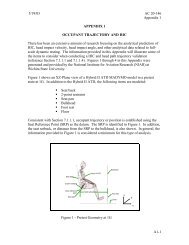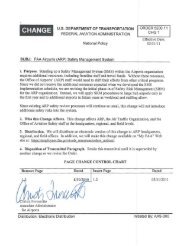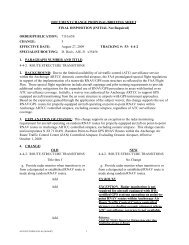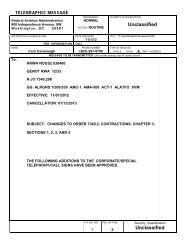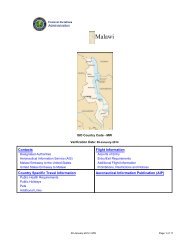2009 SMS Pilot Project (SMSPP) Analysis - FAA
2009 SMS Pilot Project (SMSPP) Analysis - FAA
2009 SMS Pilot Project (SMSPP) Analysis - FAA
You also want an ePaper? Increase the reach of your titles
YUMPU automatically turns print PDFs into web optimized ePapers that Google loves.
6. <strong>SMS</strong> Airworthiness Directives study<br />
7. Comparison of the proposed part 5 and M<strong>SMS</strong> framework<br />
All seven of the studies provided guidance and additional information to the D&M organizations.<br />
They helped justify the reasons for implementing <strong>SMS</strong> into their business processes. A brief<br />
description of each of the seven studies is provided in the following sections.<br />
5-1 Comparison of <strong>SMS</strong> and AS9100 C requirements<br />
After multiple D&M organizations asked about the differences between <strong>SMS</strong> and AS9100 C<br />
requirements, the M<strong>SMS</strong> team tasked Embry-Riddle Aeronautical University’s Center for<br />
General Aviation Research to contrast them.<br />
The comparison used the <strong>SMS</strong> FRAMEWORK: D&M Safety Management System (<strong>SMS</strong>) <strong>Pilot</strong><br />
<strong>Project</strong> Participants and Voluntary Implementation of <strong>SMS</strong> Programs, dated December 21,<br />
2010, for the <strong>SMS</strong> standard. The AS9100C source was from the SAE Aerospace Standard<br />
AS9100, Revision C.<br />
Alan J. Stolzer, Ph.D., analyzed the requirements and concluded that many of the <strong>SMS</strong><br />
requirements can be found within the <strong>FAA</strong>/AS9100 approved systems; however, they are<br />
different in both their scope and in the ways they are applied.<br />
Alan J. Stolzer, Ph.D. concluded, “AS9100C does not overtly manage safety; rather it manages<br />
quality. This is more than a semantical difference, and it is important that organizations adopting<br />
an <strong>SMS</strong> recognize that difference.”<br />
For more information, Appendix B contains a link to the study.<br />
5-2 Process of Defining a System Description<br />
The participating D&M organizations questioned how deep a company needs to go to define<br />
their system for <strong>SMS</strong> and asked whether there is a process for developing a system description.<br />
Alan J. Stolzer, Ph.D., at Embry-Riddle Aeronautical University supported this effort and wrote<br />
“System Description and Hazard Identification: A Process for Design and Manufacturing<br />
Organizations.”<br />
This document outlines a process for D&M organizations to create a system description for their<br />
specific type of organization. The document devised two examples of how the process could be<br />
applied: 1) to a small company that produces a critical part, and 2) to a large company that<br />
manufactures a complex airplane.<br />
This document shows how the system description plays a key part in a company’s <strong>SMS</strong> and<br />
supports other efforts such as safety policy, risk management, safety assurance, and safety<br />
promotion. It explains that while an organization may employ existing management systems<br />
21



